

Missouri S&T Circular Loop. EMC Laboratory 4000 Enterprise Dr.
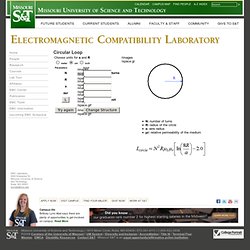
Missouri University of Scienceand TechnologyRolla, MO 65401emclab@mst.edu. Radio circuits built by Don Cross. Reflex AM receiver – August 2009 I am very pleased to report that I have finally built a radio receiver that is good enough that I can enjoyably use it!
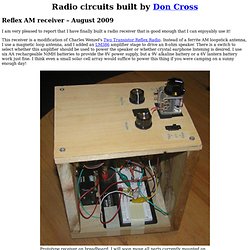
This receiver is a modification of Charles Wenzel's Two Transistor Reflex Radio. Instead of a ferrite AM loopstick antenna, I use a magnetic loop antenna, and I added an LM386 amplifier stage to drive an 8-ohm speaker. There is a switch to select whether this amplifier should be used to power the speaker or whether crystal earphone listening is desired. I use six AA rechargeable NiMH batteries to provide the 8V power supply, but a 9V alkaline battery or a 6V lantern battery work just fine. Notes about this circuit The magnetic loop antenna is depicted as a transformer. Experimental determination of inductance L and parasitic capacitance Cx Tonight (28 August 2009) I had fun with an experiment to figure out the inductance of the tuning coil (the 20 turns of magnet wire), along with its so-called "parasitic" capacitance.
C = Ct + BCf + Cx. Exp_AM_Radio_Design. AM Loop Antennas. Now QUINN approved!
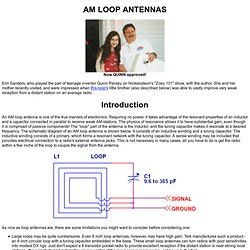
Erin Sanders, who played the part of teenage inventor Quinn Pensky on Nickelodeon's "Zoey 101" show, with the author. She and her mother recently visited, and were impressed when this loop's little brother (also described below) was able to vastly improve very weak reception from a distant station on an average radio. An AM loop antenna is one of the true marvels of electronics. Requiring no power, it takes advantage of the resonant properties of an inductor and a capacitor connected in parallel to receive weak AM stations. The physics of resonance allows it to have substantial gain, even though it is comprised of passive components! As nice as loop antennas are, there are some limitations you might want to consider before considering one: Large loops may be quite cumbersome. Many articles have been written describing the construction of loop antennas, but they have been deficient in many respects. Loop. Undefined Version 1, 7-8-2004 by Bruce Carter By entering the height and width of your loop (36 or 48 inches each if building as per above) and the number of turns and distance between turns (I use 0.5 in my design so change to that if need be) you will get the frequency range of the antenna design.

These ranges are approximate and will vary a bit depending on the capacitor you use. Those values if know can be entered but most 0-360 capacitors are actually 10-360. Below you will find plans to build a three or four foot box loop for the AM broadcast band. Here is a pic of the loop Tom Doty built with some mods to the plans above. View topic - Homebrew MW (AM) PVC Loop Antenna - My Way.. Mescalero wrote: The Litz wire is ~.1940" (5mm) in diameter and each strand is ~.007" (looks like #33awg).
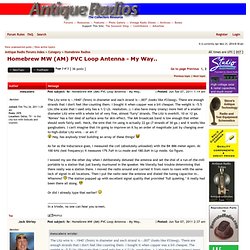
There are enough strands that I don't feel like counting them. I bought it when copper was a bit cheaper. The weight is ~5.5 Lbs (the scale that I used only has a 1/2 Lb. resolution..). AM_loop_antennas. What makes a good variable capacitor for crystal radios? By Dave Schmarder This is a question that has been asked of me many times.
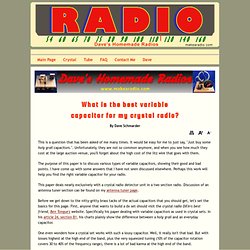
It would be easy for me to just say, "Just buy some holy grail capacitors. ". Unfortunately, they are not so common anymore, and when you see how much they cost at the large auction venue, you'll forget about the high cost of the litz wire that goes with them. The purpose of this paper is to discuss various types of variable capacitors, showing their good and bad points. I have come up with some answers that I have not seen discussed elsewhere. This paper deals nearly exclusively with a crystal radio detector unit in a two section radio. Before we get down to the nitty-gritty brass tacks of the actual capacitors that you should get, let's set the basics for this page. Simulation of EF: The Finite-Difference Time-Domain Method and Its Applications. Modify that AM antenna. Modify that AM antenna by Bruce Carter Open any radio with an AM section and you are sure to find a grayish black rectangular or round bar of metal, with wire wond around it on one end.
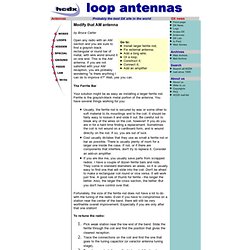
This is the AM antenna. If you are not satisfied with your AM reception, you are probably wondering "is there anything I can do to improve it? " Well, yes you can. The Ferrite Bar Your solution might be as easy as installing a larger ferrite rod. Usually, the ferrite rod is secured by wax or some other to soft material to its mountings and to the coil. Fortunately, the size of the ferrite rod does not have a lot to do with the tuning of the radio. To re-tune the radio: Pick weak station near the low end of the band. External Antenna Input Can't do anything more with the ferrite bar? Take 3 to 4 turns (no more) of 22 or 24 AWG wire, and wrap it around the end of the ferrite bar opposite the antenna coil. Instructables. Chapter 4: Radio. Send mail to Simon Quellen Field via sfield@scitoys.com.
